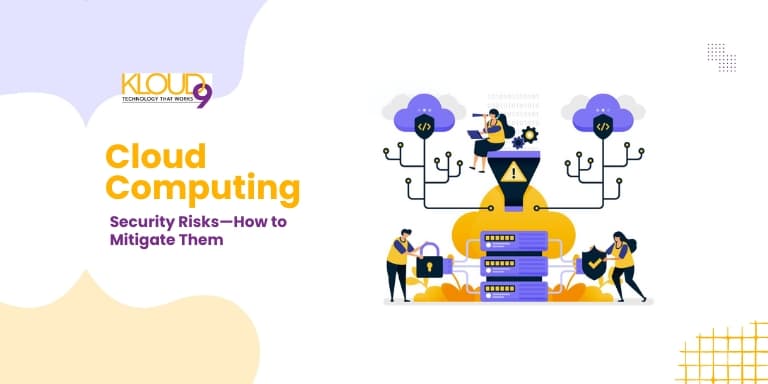Cloud computing has revolutionized business operations by offering cost-effective, scalable solutions. Cloud computing services provide unparalleled convenience, enabling enterprises to access resources and data from anywhere. However, with these advantages come unique security risks that must be addressed. Identifying these risks and implementing robust cloud infrastructure management strategies ensures businesses reap the full benefits of this technology without compromising security.
Understanding Cloud Computing Security Risks
1. Data Breaches
A data breach is one of the most significant risks of leveraging cloud-based business solutions. Storing sensitive information such as customer records, financial data, and intellectual property in the cloud exposes organizations to potential cyberattacks. Hackers often target cloud environments because of the vast amount of data they contain, making breaches more damaging.
2. Insider Threats
Not all threats come from external sources. Employees, contractors, or cloud service provider personnel can inadvertently or maliciously compromise security. Whether due to intentional sabotage or simple negligence, insider threats pose a unique challenge, especially when using cloud computing deployment models that rely on shared resources.
3. Data Loss
Data loss can result from accidental deletion, system failures, or ransomware attacks. Businesses relying solely on cloud storage without adequate backup solutions risk permanently losing vital information. Without robust cloud infrastructure management, recovery from such incidents can be extremely costly and time-consuming.
4. Insecure APIs
Application Programming Interfaces (APIs) allow cloud applications to communicate with one another. However, if these APIs lack proper security protocols, cybercriminals can exploit them to gain unauthorized access or disrupt services. Vulnerable APIs weaken the overall integrity of cloud computing services.
5. Regulatory Compliance Risks
Organizations must comply with industry regulations like GDPR, HIPAA, or PCI DSS when using cloud computing for businesses. Failure to meet these legal obligations can result in financial penalties, reputational damage, and legal disputes.
6. DDoS Attacks
Distributed Denial of Service (DDoS) attacks can overwhelm cloud servers, rendering systems inaccessible to legitimate users. These attacks disrupt business operations and may cause financial losses, particularly for organizations that heavily depend on cloud computing deployment models.
7. Multitenancy Vulnerabilities
Public cloud models often house multiple tenants on shared servers. While this setup reduces costs, it increases the risk of exploited vulnerabilities. A weakness in one tenant’s system could compromise another tenant’s data.
Mitigation Strategies for Cloud Computing Risks
1. Data Encryption
Encryption ensures that data remains secure, whether it’s in transit or at rest. By encrypting sensitive information stored in cloud-based business solutions, businesses can make it virtually impossible for unauthorized users to access readable data.
2. Strong Access Controls
Implement multi-factor authentication (MFA) and robust role-based access controls to limit who can access sensitive systems and data. These measures significantly reduce the likelihood of insider threats and unauthorized breaches.
3. Regular Security Audits
Conduct frequent security assessments to identify vulnerabilities in cloud infrastructure management. This includes penetration testing, system monitoring, and reviewing compliance with security protocols.
4. Comprehensive Backup Strategies
Automate regular backups and ensure they are stored securely in different locations. Utilizing scalable cloud solutions for disaster recovery ensures businesses can recover quickly from data loss incidents.
5. Secure API Development
APIs should be developed with security in mind, including strong authentication, encryption, and activity monitoring. Regular updates and testing are critical to maintaining the integrity of APIs used in cloud computing services.
6. Vendor Assessment
Before adopting a cloud provider, evaluate their security practices, compliance certifications, and data protection policies. Look for providers offering advanced cloud computing for enterprise features like threat detection, encryption, and 24/7 monitoring.
7. Employee Education
Train employees on cybersecurity best practices, such as recognizing phishing attempts and securing credentials. Employees are crucial in minimizing security risks in cloud computing deployment models.
8. Compliance Tools and Partnerships
Use compliance management tools or work with vendors that specialize in regulatory compliance. These tools ensure your cloud infrastructure management aligns with legal and industry standards.
9. Adopt Hybrid or Private Clouds
For highly sensitive data, consider hybrid or private cloud models. These offer greater control over security configurations than public cloud computing deployment models, reducing risk exposure.
10. Incident Response Plans
Develop and test incident response plans to handle security breaches effectively. Preparedness ensures that your organization can mitigate damage and resume operations quickly.
How Cloud Computing Benefits Businesses Amidst Risks
Despite its risks, cloud computing for businesses offers unparalleled advantages when paired with robust security measures. The key lies in balancing accessibility and protection to fully leverage the cloud computing benefits for enterprises, including:
- Scalability: Businesses can scale resources up or down based on demand.
- Cost-Efficiency: Reduced infrastructure and maintenance costs enable organizations to allocate resources to other priorities.
- Collaboration: Cloud platforms facilitate real-time collaboration, even for distributed teams.
- Innovation: Advanced AI and machine learning tools are often integrated into cloud-based business solutions.
Addressing Security Risks to Maximize Cloud Computing Benefits
The risks of cloud computing services can feel daunting, but proactive strategies ensure businesses can reap their full potential. With strong vendor partnerships, robust training, and technological safeguards, cloud infrastructure management tools and practices create a secure environment for businesses to thrive.
By understanding and addressing the vulnerabilities inherent to cloud computing deployment models, businesses can enjoy the scalability, flexibility, and innovation that cloud solutions bring. Every effort, from encrypting data to choosing trusted cloud-based business solutions, contributes to a more secure, resilient cloud environment.
In today’s digital age, staying ahead of cybersecurity threats is not optional but necessary. Empower your business with scalable cloud solutions and ensure your cloud journey is secure and prosperous. With the proper practices in place, the benefits of cloud computing will far outweigh the risks, positioning your business for long-term growth and success.
Conclusion
By proactively addressing risks through advanced security measures, scalable cloud solutions, and robust cloud infrastructure management, businesses can confidently leverage cloud computing to drive innovation and growth.





You must be logged in to post a comment.